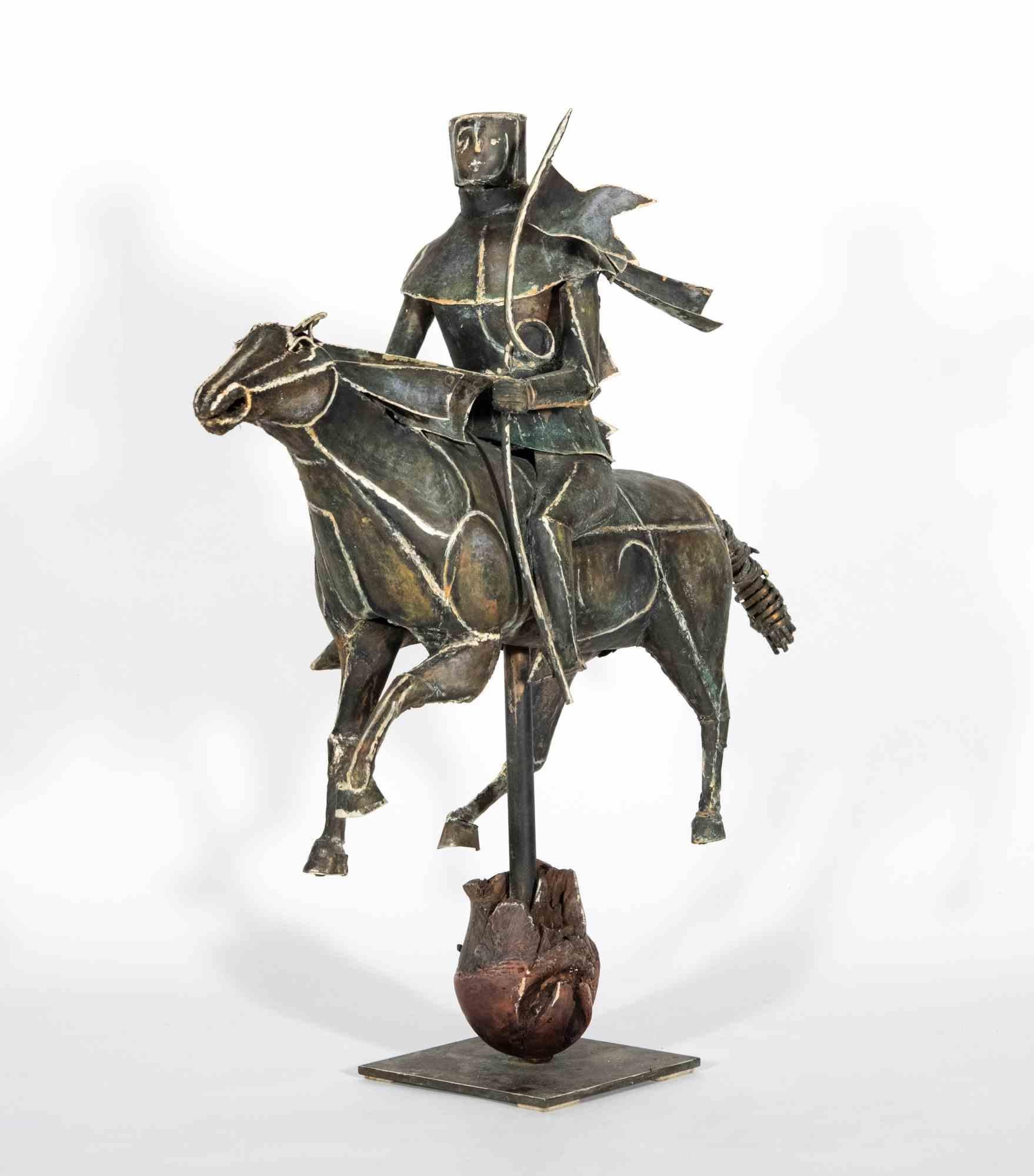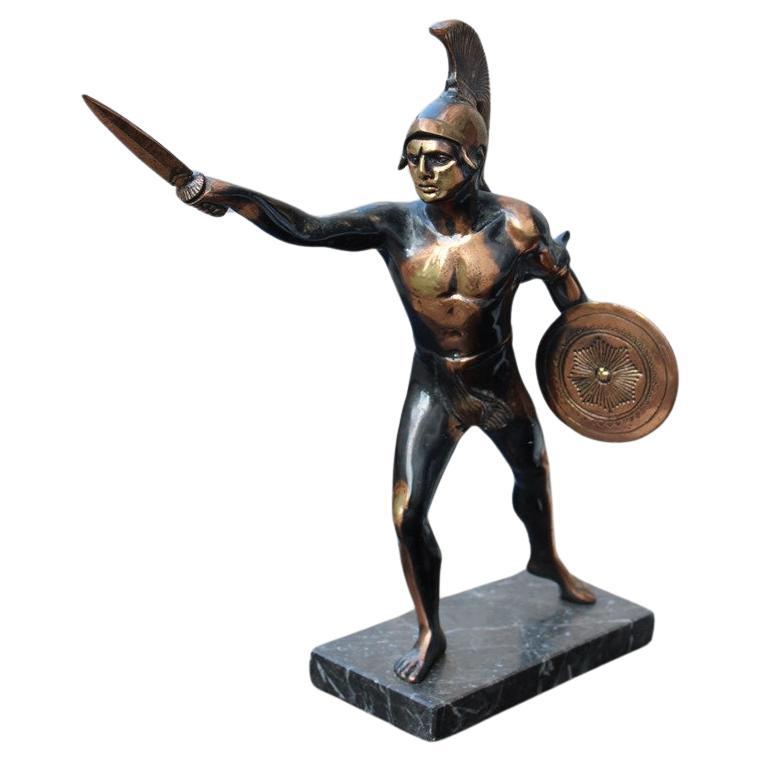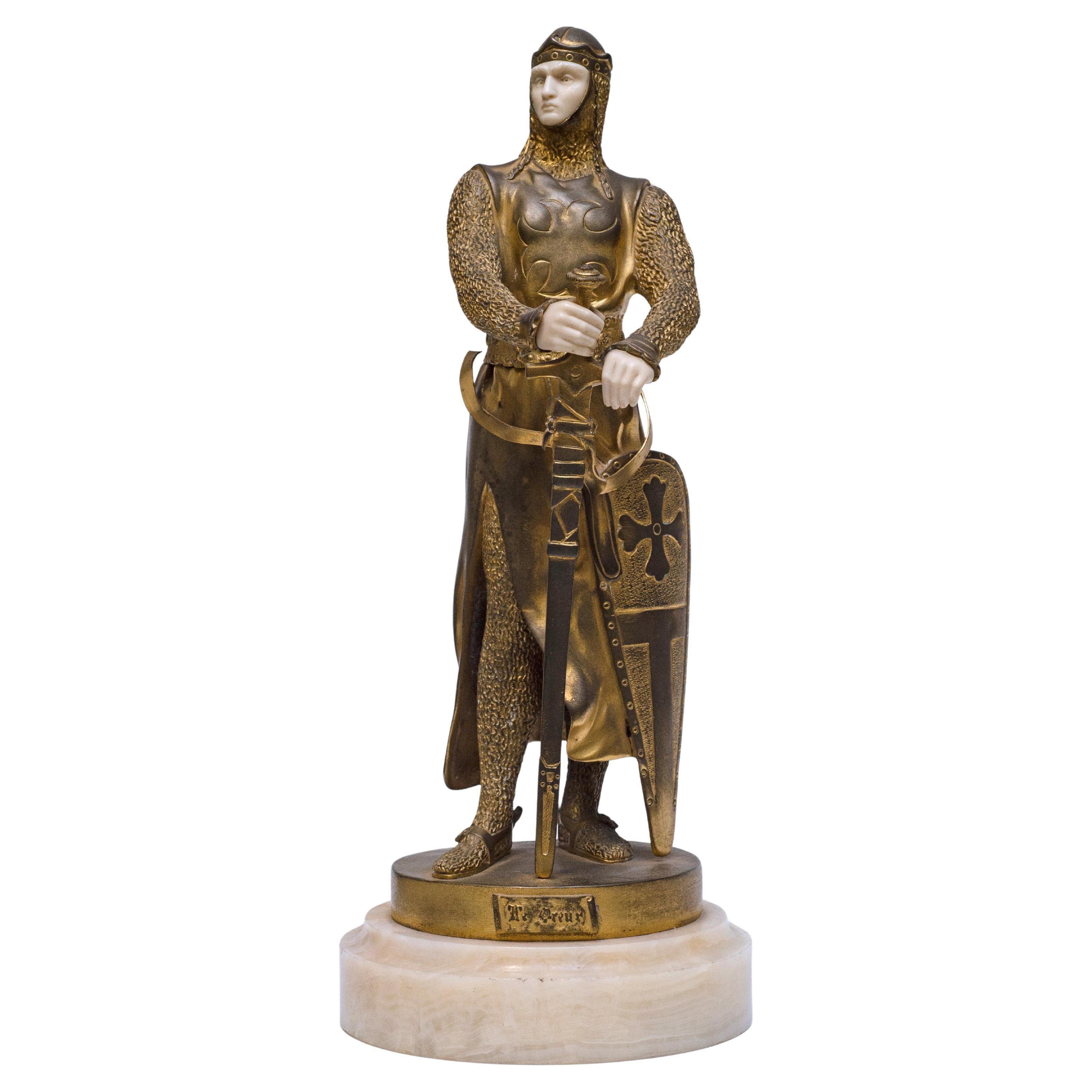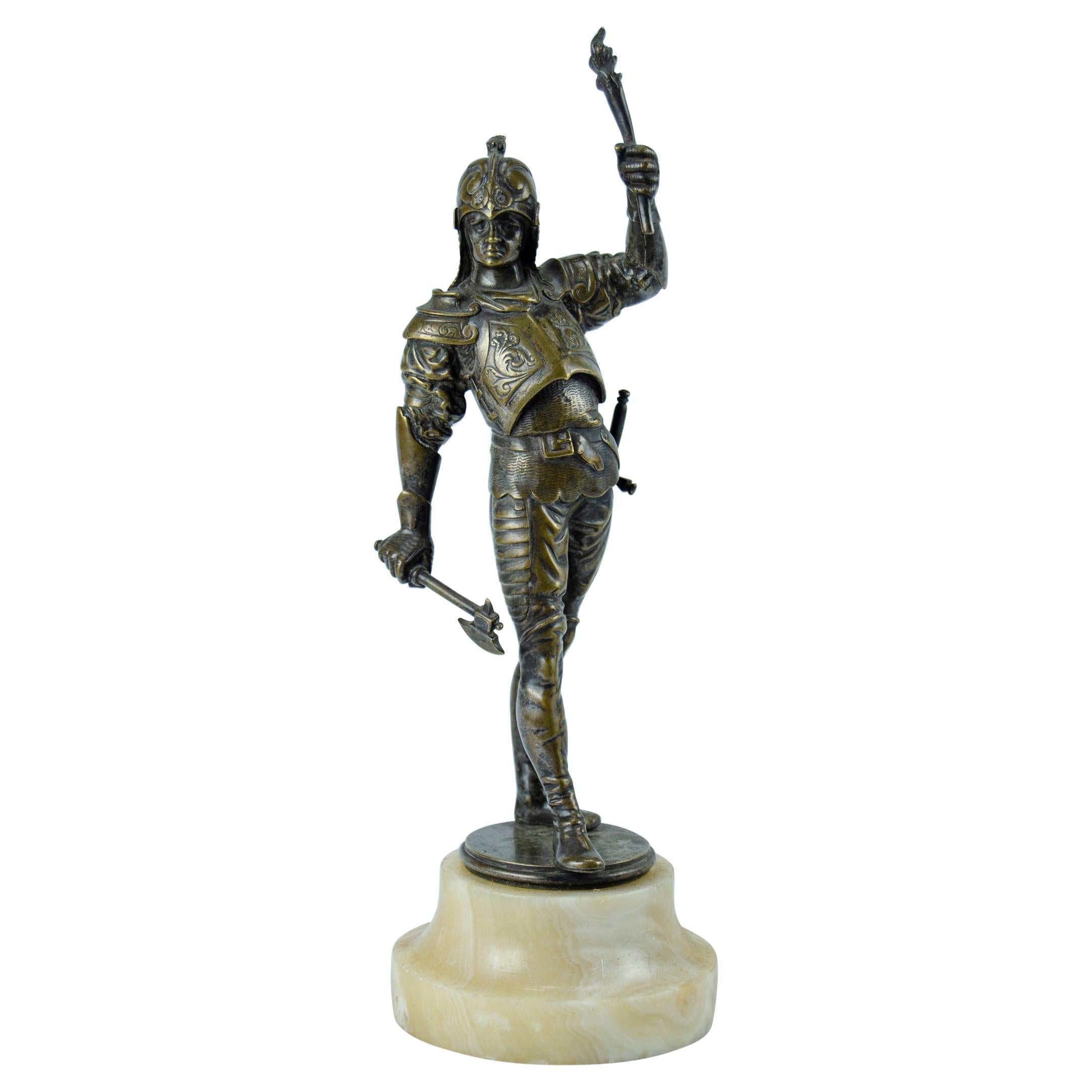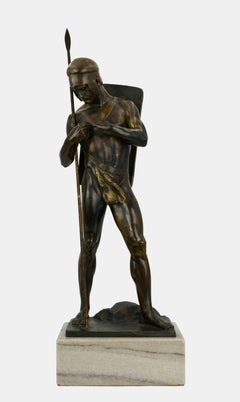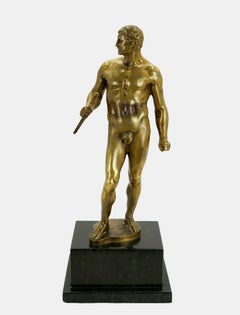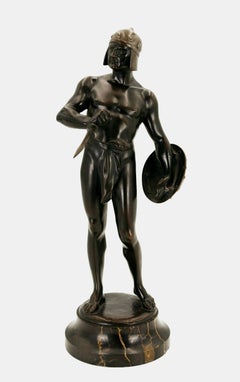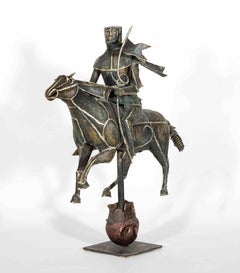Items Similar to Crusader with shield and mace / - Ready to strike -
Want more images or videos?
Request additional images or videos from the seller
1 of 14
Josef MoestCrusader with shield and mace / - Ready to strike -c. 1910
c. 1910
$6,929.11
£5,178.47
€5,800
CA$9,559.06
A$10,470.13
CHF 5,512.52
MX$124,957.54
NOK 70,252.19
SEK 64,221.09
DKK 44,208.43
About the Item
Josef Moest (1873 Cologne - 1914 Rath), Crusader with shield and mace, around 1910. Bronze on a black marble pedestal (19 cm high). 57.5 cm (total height) x 21 cm (width) x 12 cm (depth), weight 24.8 kg. Incised signature “MOEST.” on the back of the base.
- Slightly worn in places, base minimally bumped, otherwise in excellent condition
- Ready to strike -
The crusader gazes resolutely over his raised shield at the enemy, his confident posture indicating that he will not retreat in the least, defending the terrain with his tightly wrapped mace. The armor, slightly damaged on the left shoulder, bears witness to battles already fought.
However, the stance is not only a secure position, but also a purposeful retreat that turns into a lunging movement. The already tensed muscles are masterfully visible under the chain mail, anticipating the powerful blow. By dynamizing the figure in this way, Josef Moest succeeds in depicting the battle on the basis of the individual figure without illustrating the battle as such. The impression of the crusader's presence beyond the historical distance is reinforced by the extremely realistic details. The finely woven chain mail as well as the leather straps give a convincing impression of the actual material.
The positioning on the high pedestal lends the figure a monumental quality, giving a moral impetus to the inner attitude depicted.
About the artist
As the son of the Cologne sculptor, restorer and collector of medieval sculptures, Richard Moest, Josef Moest was born with an interest in sculpture. After training under the cathedral sculptor Peter Fuchs, he studied sculpture under Syrius Eberle at the Munich Academy from 1897 to 1902. Moest then opened his own studio. He quickly made a name for himself as a sculptor. He created high-quality salon sculptures and was involved in numerous church decorations. In 1904, he co-founded the Cologne artists' association “Stil”. In 1908 he took part in the exhibition at the Munich Glaspalast and in 1909 in the Great Art Exhibition of the Düsseldorf Academy. Suffering from tuberculosis, Moest designed a Pietà for his own grave in 1912, when he was just 39 years old, before he died two years later.
GERMAN VERSION
Josef Moest (1873 Köln - 1914 Rath), Kreuzritter mit Schild und Streitkolben, um 1910. Bronze auf schwarzem Marmorpostament (19 cm Höhe). 57,5 cm (Gesamthöhe) x 21 cm (Breite) x 12 cm (Tiefe), Gewicht 24,8 kg. Ritzsignatur „MOEST.“ auf der Rückseite des Sockels.
- vereinzelt leicht betrieben, Sockel minimal bestoßen, ansonsten ausgezeichnet erhalten
- Zum Hieb bereit -
Der Kreuzritter blickt über das erhobene Schild hinweg entschlossen dem Feind entgegen, während der sichere Stand davon kündet, keinen Deut zurückzuweichen und das Terrain mit dem festumschlossenen Streitkolben zu verteidigen. Die an der linken Schulter etwas lädierte Rüstung zeugt von bereits ausgefochtenen Schlachten.
Die Körperhaltung ist aber nicht allein ein sicherer Stand, sie ist zugleich ein anvisierendes Zurückweichen, das in eine Ausholbewegung übergeht. Die bereits angespannte Muskulatur zeichnet sich auf meisterhafte Weise unter dem Kettenhemd ab und antizipiert den kraftvollen Schlag. Durch diese Dynamisierung der Figur gelingt es Josef Moest, das Kampfestgeschehen anhand der Einzelfigur zur Darstellung zu bringen, ohne den Kampf als solchen zu veranschaulichen. Dabei wird der Eindruck einer über die historische Distanz hinweg gegebenen Präsenz des Kreuzritters durch die äußerst realistisch ausgearbeiteten Details verstärkt. Das feinmaschige Kettenhemd vermittelt ebenso überzeugend wie die Lederriemen den Eindruck ihrer eigentlichen materiellen Beschaffenheit.
Die Positionierung auf dem hohen Postament verleiht der Figur etwas Denkmalhaftes, wodurch die dargestellte innere Haltung einen moralischen Impetus erhält.
zum Künstler
Als Sohn des Kölner Bildhauers, Restaurators und Sammlers mittelalterlicher Skulpturen, Richard Moest, war Josef Moest das Interesse für Bildhauerei in die Wiege gelegt. Nach einer Ausbildung bei dem Dombildhauer Peter Fuchs studierte er von 1897 bis 1902 bei Syrius Eberle Bildhauerei an der Münchener Akademie. Anschließend eröffnete Moest ein eigenes Atelier. Schnell machte er sich als Bildhauer einen Namen. Er schuf qualitätvolle Salonplastiken und war an zahlreichen Kirchenausstattungen beteiligt. 1904 war er Mitbegründer der Kölner Künstlervereinigung „Stil“. 1908 nahm er an der Ausstellung im Münchner Glaspalast teil und 1909 an der Großen Kunstausstellung der Düsseldorfer Akademie. An Tuberkulose leidend, entwarf Moest 1912, mit gerade einmal 39 Jahren, eine Pietà für sein eigenes Grab, bevor er zwei Jahre später verstarb.

About the Seller
5.0
Vetted Professional Seller
Every seller passes strict standards for authenticity and reliability
Established in 2014
1stDibs seller since 2023
23 sales on 1stDibs
- ShippingRetrieving quote...Shipping from: Berlin, Germany
- Return Policy
More From This Seller
View AllSpear Fighter / - The Fighter's Concentration -
Located in Berlin, DE
Ludwig Eisenberger (active in Berlin between 1895-1920), Spear Fighter, around 1910. Brown patinated bronze with residual gilding on a cast terrain plinth with marble base (8 cm high...
Category
1910s Realist Nude Sculptures
Materials
Bronze
Naked warrior with short sword / - The New Hercules -
Located in Berlin, DE
Hermann Volz (1847 Karlsruhe - 1914 ibid.), Naked warrior with short sword, c. 1935. Partially (?) patinated bronze with cast plinth mounted on a black marble base (6.8 cm high). 32....
Category
1930s Art Deco Nude Sculptures
Materials
Bronze
Gladiator ready for battle / - Ready for anything -
By Bruno Zach
Located in Berlin, DE
Bruno Zach (1891 Zhitomir - 1945 Vienna), Gladiator ready for battle, c. 1930. Blackish patinated bronze with silver-plated helmet, shield rim and shield pommel mounted on a fluted m...
Category
1930s Art Deco Nude Sculptures
Materials
Bronze
The Victorious David / - The melancholy of the radiant hero -
Located in Berlin, DE
Henri Honoré Plé (1853 Paris - 1922 Paris), The Victorious David, around1890. Red-brown and brown patinated bronze with terrain plinth mounted on a round base. 42 cm (total height) x...
Category
1890s Realist Figurative Sculptures
Materials
Bronze
The Victorious David / - The melancholy of the radiant hero -
Located in Berlin, DE
Henri Honoré Plé (1853 Paris - 1922 Paris), The Victorious David, around 1890. Red-brown and brown patinated bronze with terrain plinth mounted on a round base. 62 cm (total height) ...
Category
1890s Realist Figurative Sculptures
Materials
Bronze
Javelin thrower / - Roman present -
By Franz Iffland
Located in Berlin, DE
Franz Iffland (1862 Tempelhof - 1935 Berlin), Javelin thrower, after 1910. Olive-black patinated bronze with cast plinth mounted on a white-veined black marble base (7 cm high). Tota...
Category
1910s Art Deco Nude Sculptures
Materials
Bronze
You May Also Like
Knight - Sculpture by Lorenzo Servalli - 1975
Located in Roma, IT
A Mighty Sculpture, in Excellent Condition, an Authentic Brass Creation of 1975, proposed by the Sculptor Lorenzo Servalli, with which the Artist cele...
Category
1970s Contemporary Figurative Sculptures
Materials
Brass
Figurative sculpture in aged metal of a Roman warrior Gladiator 1950
Located in Palermo, Sicily
Figurative sculpture in aged metal of a Roman warrior Gladiator 1950
Category
Vintage 1950s Italian Mid-Century Modern Figurative Sculptures
Materials
Metal
$325 Sale Price
65% Off
"The Crusader" by Maurice Constant
By Maurice Constant
Located in Ciudad Autónoma Buenos Aires, C
"The Crusader" by Maurice Constant (1892-1970). Bronze and ivory sculpture on marble base.
Bryan Catley (1978) "Art Deco and Other Figures" p. 120
France, CIRCA 1920
Category
Vintage 1920s Art Deco Figurative Sculptures
Materials
Marble, Bronze
"The Gallant Knight" Bronze Sculpture by John Kearney
By John Kearney 1
Located in Wiscasset, ME
Constructed out of bronze and signed Kearney on the underside of the horse. Measures 24" x 25.5" x 10" and featuring a knight on horseback.
John Kearney, 1924-2014 Chicago and env...
Category
20th Century American Mid-Century Modern Figurative Sculptures
Materials
Bronze
Bronze Sculpture Soldier in Armor
Located in Buenos Aires, Argentina
Bronze sculpture soldier in armor
Onix base origin France
circa 1900
natural wear
Very good condition
the measurements are with its base.
Category
Antique Early 1900s French Neoclassical Figurative Sculptures
Materials
Bronze
William Ludwig Bronze Figural Sculpture of a Warrior Dated 1987
By William Ludwig
Located in Peabody, MA
A 1980s bronze sculpture of a helmeted figure on a solid walnut base by Louisiana artist William Ludwig (1935-2011).. Although New England born in Hartford, CT., he was known as a so...
Category
Vintage 1980s American Post-Modern Figurative Sculptures
Materials
Bronze
